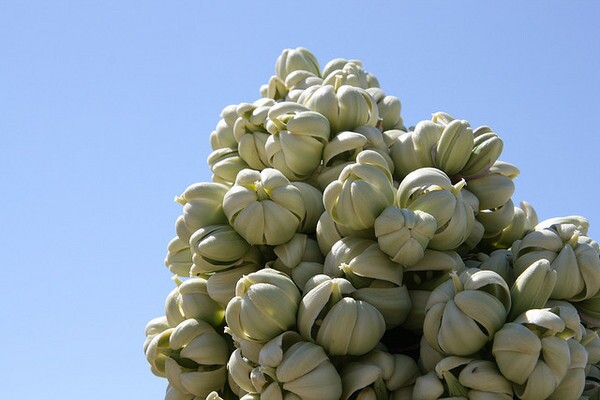Rains May Unlock An Enduring Mojave Mystery

It's make or break time. If we don't get any rain in the desert between now and March, it's not gonna happen. But if enough precipitation leaks over the mountains to give the Mojave Desert a few good showers or a blanket of snow, then we might just see one of the desert's least-understood phenomena take place, as Joshua trees work to create a new generation of themselves.
Don't get me wrong: we understand the basics quite well. In years where the Joshua trees have gotten enough winter water and a good freeze, some of the leaf buds at the ends of those ungainly branches will turn into flower buds. Between late February and April, those flower buds will open into big, tight clusters of cream-colored flowers.
At about the same time, legions of little dusky yucca moths will emerge from the ground and flit around the blossoms. The moths mate, and then the females get to work pollinating the Joshua tree's flowers. It's a remarkable process: the females have specially evolved tentacles near their mouths, unique in the insect world, with which they collect pollen and pack it into little balls. They then move from flower to flower, take a bit of pollen off the ball and wedge it into the floral ovary, thus fertilizing the flower.
After pollinating each blossom, the female moth then lays a single egg inside the ovary. As the fruit develops, that egg hatches out and the moth's larva starts eating the developing seeds. By the time the Joshua tree's dry, husky fruit is ripe that larva will have eaten about a fifth of the seeds in it, whereupon it emerges from the husk, falls to the base of the tree, and then burrows into the ground to pupate.
There are two known species of Joshua tree moth. One, Tegeticula synthetica, pollinates the western subspecies of tree, Yucca brevifolia brevifolia. The other, Tegeticula antithetica, works with the eastern tree, Yucca brevifolia jaegeriana.
The Joshua tree can't reproduce without the yucca moth. The moth can't reproduce without the tree. The relationship between the two species is a textbook example of the ecological phenomenon known as mutualism, often commonly referred to as symbiosis. Literally a textbook example, I mean: yucca moths show up in a lot of high-school biology textbooks, and they have since 19th century entomologist Charles Valentine Reilly first described the relationship in the 1890s.
Since Valentine's time we've learned a few things. Each species of yucca tends to have one species of moth that pollinates it. Yuccas keep moths from taking advantage of the relationship by dropping fruit with more than one egg: if a moth tries to game the system at the plant's expense, it ends up not reproducing.
But those are just the basics. There are a lot of things we don't know about the complexities of the relationship. For instance, we don't really know much about the moths' mating. It's presumed to take place close to the flowers, after which the males are presumed to wander off and contribute to the desert food chain. But we don't really know. There's also some question as to just how many yucca moth larvae emerge from their fruit. Do they just drop to the ground, or rappel down on a strand of silk? (Some don't even emerge: the moth that pollinates the common banana yucca, Yucca baccata, remain in the fruit's husk.)
Most critically for Joshua trees, we also have no idea what spurs the moths to emerge while the flowers are ready to be pollinated. The adult moths have only a few days' lifespan once they emerge from the soil, so bad timing could be catastrophic for both tree and moth. And the moths can remain underground in their pupal state -- called "diapause" -- for 20 years or more, so something must spur them to emerge at the right time.
It could be that the moths are stimulated to emerge by the same temperature and moisture conditions that spur flowering. Those banana yucca moths seem to be spurred by colder-than-usual winters, for instance. Joshua tree moths tend to burrow deeply, though, so they'd tend to be insulated from the climate. (No one really knows exactly how deep they dig.) Does the tree emit some sort of chemical signal when it's ready to flower? Possibly. We don't know.
This is more than just an interesting natural history puzzle. Scientists talk increasingly of the possibility that Joshua trees will be pushed into extinction throughout much of their range by climate change. We've made models based on the trees' known responses to drought, fire, and other climatic elements, but we don't know nearly as much about how the moths respond to climate change. That's obviously a big hole in the modeling: if Joshua trees happen to survive a set of conditions that kills off all the moths, we lose the trees eventually anyway.
There are even thoughts that we may have to transplant Joshua trees farther north to keep the species going, but until we learn to breed the moths as well, and to ensure that they emerge at the right time to keep both species going, our new Joshua tree plantations won't be much more than expensive wild gardens.
We need to learn a lot more about Joshua tree moths, in other words, and soon.
Chris Clarke is an environmental writer of two decades standing. He writes from Joshua Tree regularly at his acclaimed blog Coyote Crossing and comments on desert issues on KCET weekly. Read his recent posts here.


